The global automotive-grade inertial navigation system market is projected to increase from USD 410.56 million to USD 721.49 million, representing an absolute gain of USD 310.93 million at a CAGR of 5.8%. Growth reflects an overall expansion of 76% over the baseline, resulting in a market that is 1.76 times larger by the end of the forecast cycle. Market dynamics are shaped by adoption patterns across autonomous vehicle development, advanced driver assistance systems, and demand for precise vehicular positioning.
Expansion is driven by the growing need for centimeter-level navigation accuracy in both passenger and commercial vehicles. Autonomous vehicle developers prioritize inertial navigation systems (INS) as redundancy layers to GPS, ensuring reliable positioning in tunnels, dense urban areas, or under compromised signal conditions. ADAS features, such as adaptive cruise control, automated lane-keeping, and collision avoidance, increasingly require sub-meter precision, prompting manufacturers to adopt higher-grade sensors. Fleet operators are also seeking INS integration for route optimization and safety assurance. Cost improvements in MEMS-based gyroscopes and accelerometers enhance affordability, further widening the application scope.
The next decade presents opportunities through multi-sensor fusion, where inertial navigation is paired with LiDAR, radar, and vision systems to create highly reliable vehicle localization platforms. This fusion ensures fail-safe navigation in conditions where one system falters. Growth is also tied to increasing investments in Level 3 and Level 4 autonomy, which require redundant and highly accurate navigation inputs. Integration into unmanned systems, including delivery robots and autonomous shuttles, opens additional demand streams. Partnerships between OEMs and tech suppliers create opportunities for innovation in compact, automotive-grade INS modules with lower power consumption.
Between 2025 and 2030, the automotive-grade inertial navigation system market is projected to reach USD 544.25 million, representing an incremental value of USD 133.69 million. This accounts for 43% of the decade’s growth, supported by early adoption of centimeter-level precision navigation. Demand at this stage comes primarily from pilot deployments of autonomous fleets, premium vehicles equipped with advanced ADAS, and niche unmanned platforms. By 2035, the market will expand to USD 721.49 million, with USD 177.24 million added during the second half. This portion, equal to 57% of total expansion, signals a shift from limited adoption to mass integration across mainstream vehicle categories. The trajectory shows that larger gains emerge in the later stage, where multi-sensor fusion and mass-market EV platforms integrate INS as standard components.
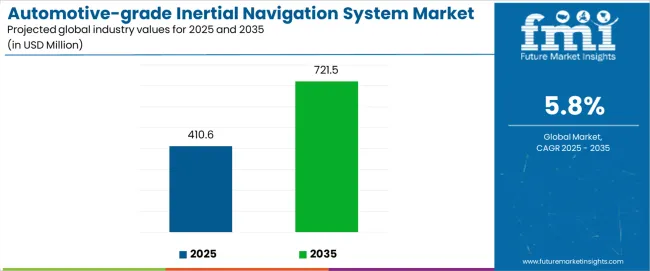
The automotive-grade inertial navigation system market demonstrates distinct growth phases with varying technological characteristics and competitive dynamics. Between 2025 and 2030, the automotive-grade inertial navigation system market progresses through its advanced sensor integration phase, expanding from USD 410.56 million to USD 544.25 million with steady annual increments averaging 5.9% growth. This period showcases the transition from basic inertial measurement units to advanced multi-axis navigation systems with enhanced sensor fusion capabilities and integrated GNSS correction becoming mainstream features.
The 2025 to 2030 phase adds USD 133.69 million to the automotive-grade inertial navigation system market value, representing 43% of the total decade expansion. Market maturation factors include standardization of accuracy specifications, declining component costs for high-precision sensors, and increasing automotive manufacturer adoption of advanced navigation systems reaching 65-70% effectiveness in autonomous driving applications. The competitive landscape during this period features established players like Honeywell and SBG System expanding their automotive portfolios, while new entrants focus on specialized ADAS solutions and enhanced real-time positioning technology.
From 2030 to 2035, market dynamics shift toward comprehensive vehicle integration and multi-platform deployment, with growth accelerating from USD 544.25 million to USD 721.49 million, adding USD 177.24 million or 57% of total expansion. This phase transition logic centers on universal high-precision systems, integration with automated driving platforms, and deployment across diverse vehicle categories, becoming standard rather than specialized navigation formats. The competitive environment matures with focus shifting from basic positioning to comprehensive sensor fusion performance and compatibility with next-generation autonomous vehicle architectures.
At-a-Glance Metrics
| Metric | Value |
|---|---|
| Market Value (2025) | USD 410.56 million |
| Market Forecast (2035) | USD 721.49 million |
| Growth Rate | 5.80% CAGR |
| Leading Accuracy Type | Sub-Meter Accuracy |
| Primary Application | ADAS Vehicle Segment |
The automotive-grade inertial navigation system market demonstrates strong fundamentals with sub-meter accuracy systems capturing a dominant share through superior positioning capabilities and cost-effective implementation advantages. ADAS vehicle applications drive primary demand, supported by increasing autonomous driving requirements and enhanced navigation management solutions.
Geographic expansion remains concentrated in developed automotive markets with established vehicle manufacturing infrastructure, while emerging economies show accelerating adoption rates driven by electric vehicle projects and rising automotive technology awareness activity.
The automotive-grade inertial navigation system market represents a compelling intersection of automotive innovation, sensor technology advancement, and navigation optimization management. With robust growth projected from USD 410.56 million in 2025 to USD 721.49 million by 2035 at a 5.80% CAGR, this market is driven by increasing autonomous vehicle expansion trends, commercial fleet requirements, and automotive demand for reliable positioning formats.
The automotive-grade inertial navigation system market's expansion reflects a fundamental shift in how automotive manufacturers and technology companies approach vehicle navigation infrastructure. Strong growth opportunities exist across diverse applications, from passenger vehicles requiring everyday navigation assistance to commercial fleets demanding high-precision solutions. Geographic expansion is particularly pronounced in Asia-Pacific markets, led by China (7.83% CAGR) and India (7.25% CAGR), while established markets in North America and Europe drive innovation and specialized segment development.
The dominance of sub-meter accuracy systems and ADAS vehicle applications underscores the importance of proven sensor technology and positional reliability in driving adoption. System complexity and manufacturing integration remain key challenges, creating opportunities for companies that can deliver consistent performance while maintaining cost efficiency.
Market expansion rests on three fundamental shifts driving adoption across automotive and transportation sectors. Autonomous vehicle development creates compelling advantages through inertial navigation systems that provide comprehensive positioning capabilities with real-time accuracy enhancement, enabling automotive manufacturers to develop advanced driving features and maintain safety standards while ensuring precise vehicle localization and justifying investment over basic GPS methods. Commercial vehicle modernization accelerates as fleet operators worldwide seek reliable navigation systems that deliver operational efficiency directly to daily operations, enabling cost reduction that aligns with logistics expectations and maximizes route optimization productivity. Electric vehicle adoption drives growth from automotive manufacturers requiring advanced navigation solutions that maximize energy efficiency while maintaining positioning accuracy during autonomous and semi-autonomous driving operations.
The growth faces headwinds from component cost variations that differ across sensor suppliers regarding price stability and supply chain reliability, potentially limiting margin consistency in price-sensitive automotive categories. Technology integration also persists regarding compatibility requirements and vehicle architecture standards that may increase complexity requirements in markets with demanding automotive protocols.
Primary Classification: The market segments by accuracy type into Sub-Meter Accuracy, Centimeter Accuracy, and Millimeter Accuracy categories, representing the evolution from basic positioning systems to advanced precision navigation formats for comprehensive autonomous vehicle operations.
Secondary Breakdown: Application segmentation divides the automotive-grade inertial navigation system market into ADAS Vehicle, Unmanned Vehicle, Advanced Navigation, Commercial Vehicle, Passenger Vehicle, and Marine Applications sectors, reflecting distinct requirements for positioning precision, real-time processing, and integration capabilities.
Regional Classification: Geographic distribution covers North America, Europe, Asia Pacific, Latin America, and the Middle East & Africa, with developed automotive markets leading innovation, while emerging economies show accelerating growth patterns driven by electric vehicle development programs.
The segmentation structure reveals technology progression from standard positioning systems toward integrated multi-sensor platforms with enhanced accuracy and real-time capabilities, while application diversity spans from passenger vehicles to specialized unmanned systems requiring comprehensive navigation and precision positioning solutions.
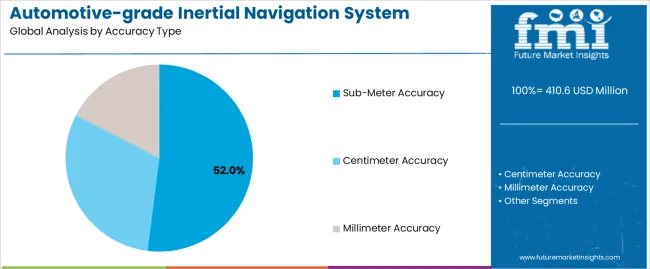
Sub-Meter Accuracy segment is estimated to account for 52% of the automotive-grade inertial navigation system market share in 2025. The segment's leading position stems from its fundamental role as a critical component in ADAS applications and its extensive use across multiple passenger vehicle and commercial vehicle sectors. Sub-Meter Accuracy's dominance is attributed to its superior cost-to-performance ratio, including reliable positioning capabilities, proven integration properties, and balanced implementation costs that make it indispensable for everyday automotive navigation operations.
Market Position: Sub-Meter Accuracy systems command the leading position in the automotive-grade inertial navigation system market through advanced sensor fusion technologies, including comprehensive GNSS integration, inertial measurement capabilities, and reliable processing performance that enable manufacturers to deploy navigation solutions across diverse vehicle environments.
Value Drivers: The segment benefits from automotive manufacturer preference for proven accuracy profiles that provide exceptional reliability without requiring premium component costs. Efficient integration processes enable deployment in passenger cars, commercial vehicles, and ADAS applications where positioning accuracy and cost efficiency represent critical selection requirements.
Competitive Advantages: Sub-Meter Accuracy systems differentiate through excellent real-time performance, proven navigation reliability, and compatibility with standard automotive electronics that enhance positioning capabilities while maintaining economical component profiles suitable for diverse automotive applications.
Key market characteristics:
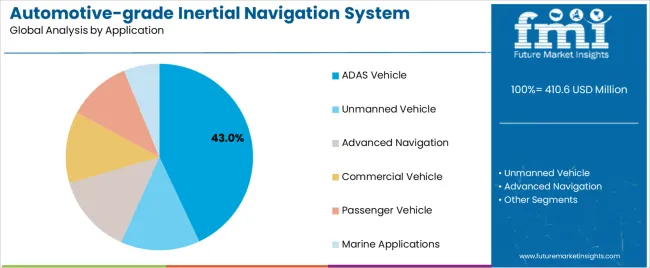
ADAS Vehicle segment is projected to hold 43% of the automotive-grade inertial navigation system market share in 2025. The segment's market leadership is driven by the extensive use of navigation systems in advanced driver assistance applications, collision avoidance systems, lane-keeping assistance, and automated parking, where inertial navigation serves as both a positioning solution and safety enhancement tool. The ADAS sector's consistent demand for reliable navigation systems supports the segment's dominant position.
Market Context: ADAS applications dominate the automotive-grade inertial navigation system market due to widespread adoption of safety-focused navigation solutions and increasing focus on autonomous driving capabilities, collision prevention, and driver assistance that enhance vehicle safety while maintaining operational standards.
Appeal Factors: Automotive manufacturers prioritize positioning accuracy, real-time processing, and integration with existing vehicle systems that enable coordinated deployment across multiple safety applications. The segment benefits from substantial regulatory requirements and safety standards that emphasize reliable navigation systems for automated driving assistance.
Growth Drivers: Vehicle safety regulations incorporate inertial navigation as standard components for collision avoidance and driver assistance programs. At the same time, autonomous driving initiatives are increasing demand for premium positioning features that comply with safety standards and enhance vehicle automation.
Market Challenges: Component cost fluctuations and integration complexity may limit deployment flexibility in ultra-price-sensitive vehicle markets or regions with varying safety requirements.
Application dynamics include:
Growth Accelerators: Autonomous vehicle development drives primary adoption as inertial navigation systems provide exceptional positioning capabilities that enable automated driving without positioning failure, supporting safety improvement and operational efficiency that require reliable sensor integration. Electric vehicle expansion accelerates market growth as automotive manufacturers seek advanced navigation solutions that maintain positioning accuracy during regenerative braking while enhancing energy efficiency through optimized routing and compatibility. Technology advancement increases worldwide, creating sustained demand for high-precision navigation systems that complement autonomous features and provide operational advantages in vehicle automation efficiency.
Growth Inhibitors: Component cost volatility challenges differ across sensor markets regarding price stability and supply chain consistency, which may limit margin predictability and cost planning in price-sensitive automotive categories with demanding affordability requirements. Integration complexity persists regarding compatibility standards and vehicle architecture requirements that may increase development costs in automotive segments with strict performance protocols. Market fragmentation across multiple accuracy specifications and processing standards creates compatibility concerns between different vehicle platforms and existing automotive electronics infrastructure.
Market Evolution Patterns: Adoption accelerates in passenger vehicle and commercial vehicle sectors where safety benefits justify technology investments, with geographic concentration in developed automotive markets transitioning toward mainstream adoption in emerging economies driven by electric vehicle development and automotive modernization. Technology advancement focuses on enhanced sensor fusion, improved processing efficiency, and integration with comprehensive vehicle platforms that optimize navigation performance and system reliability. The automotive-grade inertial navigation system market could face disruption if alternative positioning methods or regulatory changes significantly challenge traditional inertial navigation advantages in automotive applications.
The automotive-grade inertial navigation system market demonstrates varied regional dynamics with growth leaders including China (7.83% CAGR) and India (7.25% CAGR) driving expansion through electric vehicle growth and automotive modernization. Advanced Markets encompass Germany (6.67% CAGR), Brazil (6.09% CAGR), and the USA (5.51% CAGR), benefiting from established automotive manufacturing and premium vehicle adoption.
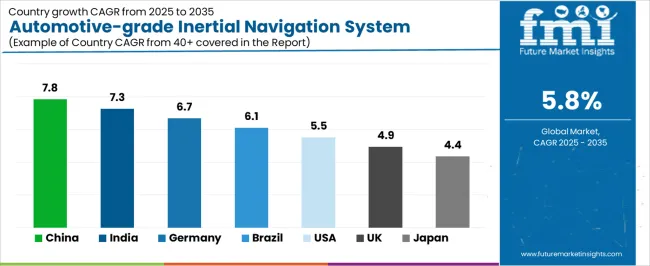
| Country | CAGR (2025-2035) |
|---|---|
| China | 7.83% |
| India | 7.25% |
| Germany | 6.67% |
| Brazil | 6.09% |
| USA | 5.51% |
| UK | 4.93% |
| Japan | 4.35% |
Regional synthesis reveals Asia-Pacific markets leading growth through automotive modernization and electric vehicle development, while European countries maintain strong expansion supported by autonomous vehicle applications and safety compliance requirements. North American markets show steady growth driven by ADAS adoption and commercial vehicle upgrades.
China establishes regional leadership through rapid electric vehicle development and comprehensive automotive technology modernization, integrating advanced inertial navigation systems as standard components in autonomous vehicles and electric vehicle platforms. The country's 7.83% CAGR through 2035 reflects automotive manufacturing growth promoting vehicle electrification and autonomous driving infrastructure that mandate the use of reliable positioning systems in automotive operations. Growth concentrates in major manufacturing centers, including Guangzhou, Shanghai, and Shenzhen, where automotive facilities showcase integrated navigation systems that appeal to vehicle manufacturers seeking enhanced positioning capabilities and international automotive technology standards.
Chinese manufacturers are developing innovative navigation solutions that combine domestic sensor technology with international accuracy specifications, including multi-sensor fusion and advanced real-time processing capabilities.
Strategic Market Indicators:
The Indian market emphasizes automotive manufacturing applications, including rapid vehicle production development and comprehensive fleet modernization that increasingly incorporates inertial navigation for commercial vehicles and passenger car applications. The country is projected to show a 7.25% CAGR through 2035, driven by massive automotive expansion under manufacturing initiatives and commercial demand for advanced, cost-effective navigation systems. Indian automotive facilities prioritize operational efficiency with navigation systems delivering positioning capabilities through economical sensor integration and reliable performance characteristics.
Technology deployment channels include major automotive manufacturers, fleet operators, and vehicle assembly facilities that support high-volume usage for domestic and export applications.
Performance Metrics:
The German market emphasizes advanced inertial navigation features, including innovative sensor technologies and integration with comprehensive automotive platforms that manage passenger vehicles, commercial applications, and autonomous driving through unified positioning systems. The country is projected to show a 6.67% CAGR through 2035, driven by automotive expansion under Industry 4.0 development trends and automotive demand for premium, reliable navigation systems. German automotive manufacturers prioritize precision with navigation systems delivering comprehensive positioning through enhanced accuracy protection and engineering innovation.
Technology deployment channels include major automotive companies, technology suppliers, and research facilities that support custom development for premium operations.
Performance Metrics:
In São Paulo, Rio de Janeiro, and Belo Horizonte, Brazilian automotive facilities and commercial fleet operators are implementing advanced inertial navigation systems to enhance vehicle capabilities and support operational efficiency that aligns with safety protocols and fleet management standards. The Brazilian market demonstrates sustained growth with a 6.09% CAGR through 2035, driven by automotive expansion programs and commercial investments that emphasize reliable positioning systems for passenger and commercial vehicle applications. Brazilian automotive facilities are prioritizing navigation systems that provide exceptional accuracy while maintaining compliance with local standards and minimizing integration complexity, particularly important in commercial vehicle operations and fleet management applications.
Market expansion benefits from automotive development programs that mandate enhanced positioning in vehicle specifications, creating sustained demand across Brazil's automotive and transportation sectors, where navigation reliability and cost efficiency represent critical requirements.
Strategic Market Indicators:
The USA market emphasizes advanced navigation system features, including innovative positioning technologies and integration with comprehensive automotive platforms that manage ADAS applications, autonomous vehicles, and commercial operations through unified navigation systems. The country is projected to show a 5.51% CAGR through 2035, driven by automotive expansion under autonomous driving development trends and commercial demand for premium, reliable positioning systems. American automotive manufacturers prioritize innovation with navigation systems delivering comprehensive vehicle automation through enhanced safety protection and operational advancement.
Technology deployment channels include major automotive companies, technology providers, and research institutions that support custom development for autonomous operations.
Performance Metrics:
The UK market demonstrates sophisticated automotive navigation deployment, growing at 4.93% CAGR, with documented operational excellence in passenger vehicles and commercial applications through integration with existing automotive electronics and quality assurance infrastructure. The country leverages engineering expertise in sensor technology and automotive integration to maintain market competitiveness. Automotive centers, including Birmingham, Coventry, and Oxford, showcase advanced installations where navigation systems integrate with comprehensive vehicle platforms and safety systems to optimize automotive performance and operational efficiency.
British automotive facilities prioritize positioning precision and system reliability in technology selection, creating demand for premium navigation systems with advanced features, including multi-sensor integration and compatibility with automated vehicle protocols. The automotive-grade inertial navigation system market benefits from established automotive infrastructure and willingness to invest in specialized navigation technologies that provide superior accuracy and regulatory compliance.
Market Intelligence Brief:
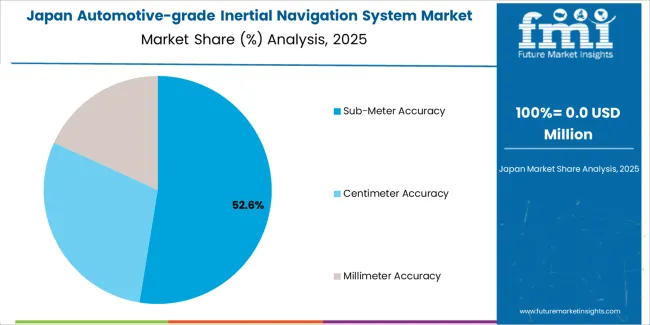
Japan's sophisticated automotive market demonstrates meticulous navigation system deployment, growing at 4.35% CAGR, with documented operational excellence in precision manufacturing and automotive applications through integration with existing vehicle systems and technology infrastructure. The country leverages engineering expertise in sensor manufacturing and automotive electronics to maintain market leadership. Manufacturing centers, including Tokyo, Nagoya, and Yokohama, showcase advanced installations where navigation systems integrate with comprehensive automotive platforms and manufacturing systems to optimize vehicle performance and production efficiency.
Japanese automotive facilities prioritize navigation precision and component reliability in product selection, creating demand for premium navigation systems with advanced features, including ultra-precise positioning and integration with automated manufacturing protocols. The automotive-grade inertial navigation system market benefits from established automotive infrastructure and commitment to investing in specialized sensor technologies that provide superior performance and quality assurance.
Market Intelligence Brief:
The automotive-grade inertial navigation system market in Europe is projected to grow from USD 89.2 million in 2025 to USD 134.7 million by 2035, registering a CAGR of 4.2% over the forecast period. Germany is expected to maintain its leadership position with a 38.4% market share in 2025, declining slightly to 37.8% by 2035, supported by its automotive manufacturing excellence and major production centers, including Baden-Württemberg and North Rhine-Westphalia.
France follows with a 23.6% share in 2025, projected to reach 24.1% by 2035, driven by comprehensive automotive development programs and electric vehicle initiatives. The United Kingdom holds a 17.2% share in 2025, expected to maintain 17.6% by 2035 through established automotive sectors and premium vehicle adoption. Italy commands a 11.8% share, while Spain accounts for 6.5% in 2025. The Rest of Europe region is anticipated to gain momentum, expanding its collective share from 2.5% to 3.2% by 2035, attributed to increasing automotive development in Eastern European countries and emerging electric vehicle programs implementing advanced navigation systems.
The automotive-grade inertial navigation system market operates with moderate concentration, featuring approximately 15-20 participants, where leading companies control roughly 45-52% of the global market share through established automotive partnerships and comprehensive sensor technology capabilities. Competition emphasizes positioning accuracy, integration compatibility, and cost efficiency rather than premium feature rivalry.
Market leaders encompass Honeywell, SBG System, and OxTS, which maintain competitive advantages through extensive sensor manufacturing expertise, global automotive networks, and comprehensive technical support capabilities that create manufacturer loyalty and support automotive requirements. These companies leverage decades of navigation technology experience and ongoing sensor development investments to develop advanced inertial navigation systems with exceptional accuracy and integration features.
Specialty challengers include Inertial LAB (VIAVI Solutions), Shanghai Huace Navigation Technology, and Hubei Leador Space Information Technology, which compete through specialized automotive innovation focus and efficient manufacturing solutions that appeal to vehicle manufacturers seeking reliable positioning formats and custom integration flexibility. These companies differentiate through operational efficiency emphasis and specialized automotive focus.
Market dynamics favor participants that combine consistent positioning performance with advanced integration support, including automotive-grade certification and compatibility capabilities. Competitive pressure intensifies as traditional sensor manufacturers expand into automotive navigation systems. At the same time, specialized automotive technology companies challenge established players through innovative sensor fusion and cost-effective production targeting emerging electric vehicle segments.
| Item | Value |
|---|---|
| Quantitative Units | USD 410.56 million |
| Accuracy Type | Sub-Meter Accuracy, Centimeter Accuracy, Millimeter Accuracy |
| Application | ADAS Vehicle, Unmanned Vehicle, Advanced Navigation, Commercial Vehicle, Passenger Vehicle, Marine Applications |
| Regions Covered | North America, Europe, Asia Pacific, Latin America, Middle East & Africa |
| Countries Covered | USA, Germany, Japan, China, India, UK, Brazil, and 25+ additional countries |
| Key Companies Profiled | Honeywell, SBG System, OxTS, Inertial LAB (VIAVI Solutions), Shanghai Huace Navigation Technology, Hubei Leador Space Information Technology |
| Additional Attributes | Dollar sales by accuracy type and application categories, regional adoption trends across North America, Europe, and Asia-Pacific, competitive landscape with sensor manufacturers and automotive technology companies, automotive manufacturer preferences for positioning characteristics and integration performance, compatibility with vehicle electronics systems and autonomous driving platforms, innovations in sensor fusion technology and multi-axis systems, and development of specialized navigation solutions with enhanced real-time processing and automotive-grade reliability |
The global automotive-grade inertial navigation system market is estimated to be valued at USD 410.6 million in 2025.
The market size for the automotive-grade inertial navigation system market is projected to reach USD 721.5 million by 2035.
The automotive-grade inertial navigation system market is expected to grow at a 5.8% CAGR between 2025 and 2035.
The key product types in automotive-grade inertial navigation system market are sub-meter accuracy, centimeter accuracy and millimeter accuracy.
In terms of application, adas vehicle segment to command 43.0% share in the automotive-grade inertial navigation system market in 2025.






Full Research Suite comprises of:
Market outlook & trends analysis
Interviews & case studies
Strategic recommendations
Vendor profiles & capabilities analysis
5-year forecasts
8 regions and 60+ country-level data splits
Market segment data splits
12 months of continuous data updates
DELIVERED AS:
PDF EXCEL ONLINE
Inertial Sensing Products Market Size and Share Forecast Outlook 2025 to 2035
Inertial Navigation System Market
System-On-Package Market Size and Share Forecast Outlook 2025 to 2035
Systems Administration Management Tools Market Size and Share Forecast Outlook 2025 to 2035
Systemic Sclerosis Treatment Market - Trends & Forecast 2025 to 2035
System on Module Market Growth – Trends & Forecast 2025 to 2035
SLE Drugs Market Insights - Growth & Forecast 2025 to 2035
Systemic Mastocytosis Treatment Market
Systemic Infection Treatment Market
5G System Integration Market Insights - Demand & Growth Forecast 2025 to 2035
VRF Systems Market Growth - Trends & Forecast 2025 to 2035
Rail System Dryer Market Size and Share Forecast Outlook 2025 to 2035
HVAC System Analyzer Market Size and Share Forecast Outlook 2025 to 2035
DWDM System Market Analysis by Services, Product, Vertical, and Region – Growth, Trends, and Forecast from 2025 to 2035
Brake System Market Size and Share Forecast Outlook 2025 to 2035
Cloud Systems Management Software Market Size and Share Forecast Outlook 2025 to 2035
Hi-Fi Systems Market Size and Share Forecast Outlook 2025 to 2035
X-ray System Market Analysis - Size, Share, and Forecast 2025 to 2035
Power System Simulator Market Growth - Trends & Forecast 2025 to 2035
Cough systems Market

Thank you!
You will receive an email from our Business Development Manager. Please be sure to check your SPAM/JUNK folder too.
Chat With
MaRIA